Lindsay Townsend's Blog, page 23
September 21, 2011
4.5 Red Roses for 'Palace of the Fountains'
 I'm thrilled by this 4.5 Red Roses for my romantic suspense, 'Palace of the Fountains' by the review site Red Roses for Authors.
I'm thrilled by this 4.5 Red Roses for my romantic suspense, 'Palace of the Fountains' by the review site Red Roses for Authors.Red Roses for Authors:
This is an excellent romantic suspense that will keep the reader on the edge of their seat as they read this one. The story slowly pulls the reader in and before the reader knows it they are hooked and not willing to put this one down until they find out just what is the truth. The twists and turns are brilliantly subtle and will keep the reader guessing as to who is behind everything and just what exactly is going on. This is one to pick and read as the reader will not be disappointed in the end. I give this one 4-1/2 red roses.
Published on September 21, 2011 10:43
September 15, 2011
4.5 Books from Long and Short Reviews for 'To Touch The Knight'
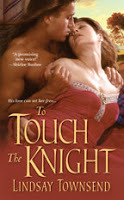 I'm thrilled to report that Aloe of Long and Short Reviews has given my To Touch the Knight a review of 4.5 books. Here's her review:
I'm thrilled to report that Aloe of Long and Short Reviews has given my To Touch the Knight a review of 4.5 books. Here's her review:There is pestilence in the land and serfs are dying. Edith's Lord decides to handle the matter expediently. He herds all the living serfs into the church building, mixing the healthy with the sick, and bars the doors. What does he care if they all die? He can always get more serfs.
It's easy to see that this author has done some research on this historical era. She emphasizes the difference between good Lords and bad, she shows insight on the character of knights that joust (they are no better than the man they are to begin with), and she shows how hopeless it is to be a serf under a bad Lord.
Ms. Townsend gives both of her lead characters strong personalities and a will to survive. Edith attends the tourneys with her friends, impersonating an Eastern princess. She manages to feed them with goods given them by knights who are seeking her attention and her hand. Sir Ranulf is a widower who only attends the jousts to keep his mind from dwelling on his dead wife; he takes no pleasure in it.
I really enjoyed how this author made Edith a spitfire who spars words with Ranulf. He snaps back, often regretting his quick words. In no time at all, the sparks flying between them are not just words, he's determined to bed her. Of course, she's determined to bed him, too, so that's all right. I laughed out loud at the times they got close to "bed" and were interrupted by staff. Seems the best laid plans of mice and men didn't seem to work out…
Danger is close, pestilence still exists, and Edith's old Lord is after her, adding a tremendous amount of suspense, so the words pass quickly as you read. This was an exciting tale with plenty of plot strings crossing back and forth to keep your interest.
Why not take a trip in time back to medieval England and follow Edith's adventures? Her life was a trial, but it was going to get better…
Published on September 15, 2011 04:45
September 7, 2011
'A definite must read' - 4.5 ribbons from Romance Junkies
 The reviews add up for To Touch the Knight, this time 4.5 ribbons from Lydia at Romance Junkies, who says: 'You will fall in love with the sensuous, but sweet interactions between Sir Ranulf and the mysterious princess as their story takes us on a journey through one of the most horrific times in history. A definite must read...'
The reviews add up for To Touch the Knight, this time 4.5 ribbons from Lydia at Romance Junkies, who says: 'You will fall in love with the sensuous, but sweet interactions between Sir Ranulf and the mysterious princess as their story takes us on a journey through one of the most horrific times in history. A definite must read...'Here's the link to the full thing.
Published on September 07, 2011 01:45
September 3, 2011
'To Touch The Knight' a Recommended Read at Joyfully Reviewed
The review site Joyfully Reviewed have made my 'To Touch The Knight' a recommended read.
Joyfully Reviewed:
To Touch The Knight is a finely woven tale that has more than one intrigue you don't expect in a historical. Ms. Townsend is able to bring forth a happy ending to a group of people who were horrifically affected by the plague. I was so intrigued by the plot in To Touch The Knight I was unable to put it down until I finished the last page. If you want a little different historical romance then I Joyfully Recommend To Touch The Knight.

Joyfully Reviewed:
To Touch The Knight is a finely woven tale that has more than one intrigue you don't expect in a historical. Ms. Townsend is able to bring forth a happy ending to a group of people who were horrifically affected by the plague. I was so intrigued by the plot in To Touch The Knight I was unable to put it down until I finished the last page. If you want a little different historical romance then I Joyfully Recommend To Touch The Knight.
Published on September 03, 2011 03:33
August 29, 2011
'All About Romance' reviews 'To Touch the Knight'
 To Touch the Knight
has been given a detailed and positive review by AAR today. I've put some paragraphs from it here - to read the whole thing, please go to their review page.
To Touch the Knight
has been given a detailed and positive review by AAR today. I've put some paragraphs from it here - to read the whole thing, please go to their review page.
Published on August 29, 2011 08:16
August 26, 2011
A Medieval Summer - a picture blog

My latest historical romance, To Touch The Knight, takes place in summer, a tense summer just after the outbreak of plague in 1348, when people are trying to return to normal.
 In more usual years, summer for people in the Middle Ages was both very busy and a time of relaxation and pleasure. After the hard graft of winter and spring, May was a holiday month in early summer, with few tasks in the agricultural calendar. May Day, a blend of Christian and older pagan traditions, was celebrated by everyone, with dancing, revels and drink.
In more usual years, summer for people in the Middle Ages was both very busy and a time of relaxation and pleasure. After the hard graft of winter and spring, May was a holiday month in early summer, with few tasks in the agricultural calendar. May Day, a blend of Christian and older pagan traditions, was celebrated by everyone, with dancing, revels and drink.  May was the time when people would go wandering in the fields and woodlands, to enjoy the fresh greenery and woodland flowers. It was also blossom time, when the fruit trees and hedgerows burst into bloom, wild cherries and wild apples following each other in glorious profusion.
May was the time when people would go wandering in the fields and woodlands, to enjoy the fresh greenery and woodland flowers. It was also blossom time, when the fruit trees and hedgerows burst into bloom, wild cherries and wild apples following each other in glorious profusion. 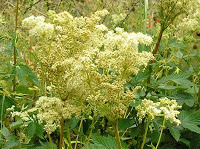 Later summer was a harder task-master: if a peasant worked on the land, later summer was when the sheep were sheared, then the hay and wheat harvests were gathered in. Summer, too, was often the prime time for military activity, when knights might be called to fight for their overlord or king on campaign. However, even in these months there was merry-making.
Later summer was a harder task-master: if a peasant worked on the land, later summer was when the sheep were sheared, then the hay and wheat harvests were gathered in. Summer, too, was often the prime time for military activity, when knights might be called to fight for their overlord or king on campaign. However, even in these months there was merry-making.  Midsummer was marked by bonfires, a pagan 'left-over' from the earlier festival of Beltane and celebrated in the Middle Ages as the saint's day of St John. Young couples would sometimes leap over the midsummer bonfire for luck. Wells could also be dressed with flowers around this time – a relic of earlier water-spirit worship, and still carried on today.
Midsummer was marked by bonfires, a pagan 'left-over' from the earlier festival of Beltane and celebrated in the Middle Ages as the saint's day of St John. Young couples would sometimes leap over the midsummer bonfire for luck. Wells could also be dressed with flowers around this time – a relic of earlier water-spirit worship, and still carried on today.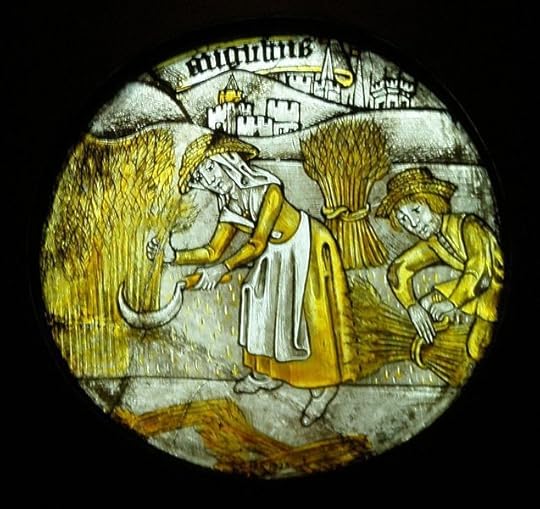 July was marked by St Swithin's day, when the strewings in the churches would be changed from the winter rushes and straw to the summer hay and sedges, and August saw the feast time of Lammas – loaf mass – to give thanks for the hard-won harvest.
July was marked by St Swithin's day, when the strewings in the churches would be changed from the winter rushes and straw to the summer hay and sedges, and August saw the feast time of Lammas – loaf mass – to give thanks for the hard-won harvest. [Photo of oxeye daisies and cornflowers by Colin Smith, photo of well-dressing by Bob Embleton, both of geograph.org.uk. The fifteenth-century stained glass harvesting scene is from the Victoria and Albert Museum. All three sourced from Wikimedia Commons.]
Published on August 26, 2011 04:50
August 18, 2011
Fleeting fashions: clothing fads in the Middle Ages
 For many centuries in the Middle Ages, the basics of fashion for men and women remained the same - a gown for women and a long or short robe or tunic for men. Fashions for sleeves, hats and shoes could be more fleeting or even extreme and it's those I'm looking at today, particularly in Britain.
For many centuries in the Middle Ages, the basics of fashion for men and women remained the same - a gown for women and a long or short robe or tunic for men. Fashions for sleeves, hats and shoes could be more fleeting or even extreme and it's those I'm looking at today, particularly in Britain.The sleeveless tunic, based on a knight's surcoat, was a popular clothing choice for medieval men. Then in the middle of the 13th century there was a brief fashion which added wide sleeves to the tunic and sometimes a hood, turning it into a garment called a gardecorps. This was intended to replace the surcoat and cloak, combining both into a single item, however it never really caught on. Still with sleeves and male fashion, the bag-sleeve for men, a wide, baggy sleeve snug at the wrist and shoulder, was popular for about twenty years around 1400, but again never really caught on.
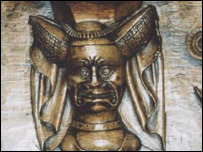 For medieval women, hair and headdresses tended to be 'the thing'. Between 1130-50 there was a fashion for noble women to wear their hair long in plaits and for them to sheath these plaits in silk, usually white with red circular stripes. These sheaths were called fouriaux. However it was with headdresses that medieval noble-women especially indulged and which set the medieval clerics scolding about excess and vanity. A brief fashion, lasting roughly thirty years, was the heart-shaped head-dress, a headgear designed with two 'horns' on either side of the woman's head. Sometimes these headdresses became even wider, which caused a cleric of the time to remark: "She is hornyd like a kowe... for syn." At Ludlow, within the church of St Laurence, there is a misericord carved with a woman portrayed as a scold - and wearing a horned headdress. Women in later years wore the steeple headdress or hennin, a tall cone arrayed with long, flowing veils, although this tended to be a European than British fashion. This was also railed against by clerics, particularly in France.
For medieval women, hair and headdresses tended to be 'the thing'. Between 1130-50 there was a fashion for noble women to wear their hair long in plaits and for them to sheath these plaits in silk, usually white with red circular stripes. These sheaths were called fouriaux. However it was with headdresses that medieval noble-women especially indulged and which set the medieval clerics scolding about excess and vanity. A brief fashion, lasting roughly thirty years, was the heart-shaped head-dress, a headgear designed with two 'horns' on either side of the woman's head. Sometimes these headdresses became even wider, which caused a cleric of the time to remark: "She is hornyd like a kowe... for syn." At Ludlow, within the church of St Laurence, there is a misericord carved with a woman portrayed as a scold - and wearing a horned headdress. Women in later years wore the steeple headdress or hennin, a tall cone arrayed with long, flowing veils, although this tended to be a European than British fashion. This was also railed against by clerics, particularly in France.All classes craved fashion, as can be seen by the various sumptuary laws passed in 1363 and 1463 which tried to stop 'lower' classes dressing in furs and certain fabrics and aping their 'betters'. Such acts made no difference as people loved to dress up.
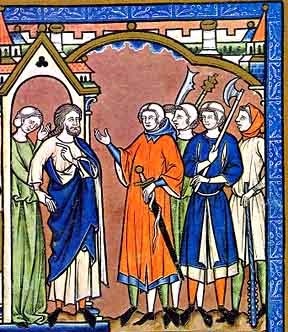 Men's vanity was often shown in shoes. Piked shoes - shoes with points - were popular with men in the Middle Ages, although the length of the points varied through the years. The truly exaggerated points were a short fashion. The idea that men wore the long points with chains attached to their knees to stop them tripping up may simply have been a mistake or a later urban myth. However, such cramped shoes did cause medieval people to have real problems with their feet, similar to those found in women of the 1950s who wore pinching, pointed-toed stilettos. An archaeologist working in Ipswich found evidence in a medieval cemetery of people with painful feet as a result of their shoes.
Men's vanity was often shown in shoes. Piked shoes - shoes with points - were popular with men in the Middle Ages, although the length of the points varied through the years. The truly exaggerated points were a short fashion. The idea that men wore the long points with chains attached to their knees to stop them tripping up may simply have been a mistake or a later urban myth. However, such cramped shoes did cause medieval people to have real problems with their feet, similar to those found in women of the 1950s who wore pinching, pointed-toed stilettos. An archaeologist working in Ipswich found evidence in a medieval cemetery of people with painful feet as a result of their shoes. Everyone, it seems, suffers for fashion, no matter how short-lived that fashion may be.
Published on August 18, 2011 09:50
August 9, 2011
The rain in Spain...
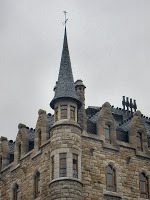 ...falls mainly on the author. Since Palace of the Fountains is out today, here are a few pics from my time doing a bit of location research in León, northern Spain. I've included a view (in the rain) of the splendid cathedral, the turrets of Gaudí's 'Casa Botines' (a bank), three peacocks from a city park, two of them snoozing. And a menu. And a toyshop. And some trees in blossom. Ah, memories!
...falls mainly on the author. Since Palace of the Fountains is out today, here are a few pics from my time doing a bit of location research in León, northern Spain. I've included a view (in the rain) of the splendid cathedral, the turrets of Gaudí's 'Casa Botines' (a bank), three peacocks from a city park, two of them snoozing. And a menu. And a toyshop. And some trees in blossom. Ah, memories!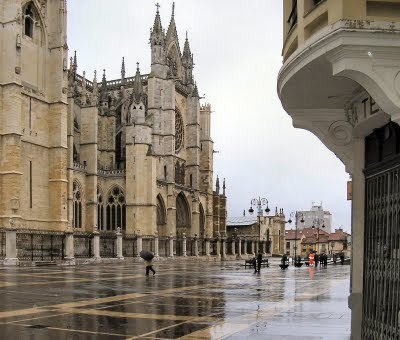
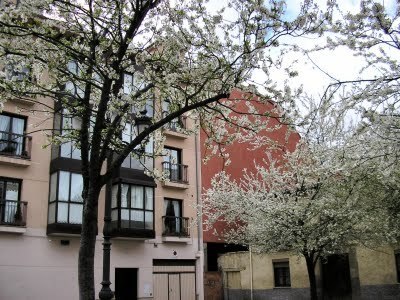
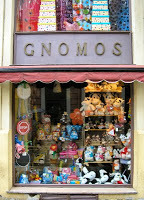
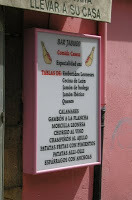

Published on August 09, 2011 09:02
July 31, 2011
'Palace of the Fountains' available for pre-order
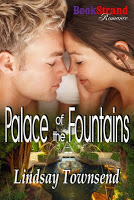 My new romantic suspense title, Palace of the Fountains, is now ready to pre-order from Bookstrand at a discount until mid-August.
My new romantic suspense title, Palace of the Fountains, is now ready to pre-order from Bookstrand at a discount until mid-August. Here's the link.
Published on July 31, 2011 06:05
July 26, 2011
Inspiring a heroine: 'Princess Caraboo'
[image error]
In To Touch The Knight, my heroine Edith pretends to be an exotic eastern princess, The Lady of Lilies, to save herself and her fellow villagers from starvation after the pestilence (the Black Death, which struck England in 1348).
Edith is a peasant woman and blacksmith, but presents herself as a strange princess with her own seductive costumes, language and customs. One of my inspirations for this particular desperate deception was a real-life fake from the eighteenth century, the Princess Caraboo.
This 'princess' was a young woman who appeared in a Gloucestershire village in 1817, dressed in unusual clothes and speaking a strange language. Upon investigation by the local magistrate, it was discovered she called herself Caraboo and later a sailor claimed he knew her language and translated her story. Caraboo claimed to be a princess from an island in the Indian ocean, who had escaped after being captured by pirates.
[image error] The magistrate, Stephen Worrall, and his wife took in Princess Caraboo. She lived with them for several weeks, famous and fêted by the local community.
In reality Princess Caraboo turned out to be Mary Baker, the daughter of an English cobbler. When the hoax was revealed due to her picture in the 'Bristol Journal' being recognized, the Worralls arranged for Mary to leave for Philadelphia.
Mary did go to America but returned later to England and died there. It was the story of her unusual deception that inspired a 1994 film, Princess Caraboo and partly inspired my own novel.

Edith is a peasant woman and blacksmith, but presents herself as a strange princess with her own seductive costumes, language and customs. One of my inspirations for this particular desperate deception was a real-life fake from the eighteenth century, the Princess Caraboo.
This 'princess' was a young woman who appeared in a Gloucestershire village in 1817, dressed in unusual clothes and speaking a strange language. Upon investigation by the local magistrate, it was discovered she called herself Caraboo and later a sailor claimed he knew her language and translated her story. Caraboo claimed to be a princess from an island in the Indian ocean, who had escaped after being captured by pirates.
[image error] The magistrate, Stephen Worrall, and his wife took in Princess Caraboo. She lived with them for several weeks, famous and fêted by the local community.
In reality Princess Caraboo turned out to be Mary Baker, the daughter of an English cobbler. When the hoax was revealed due to her picture in the 'Bristol Journal' being recognized, the Worralls arranged for Mary to leave for Philadelphia.
Mary did go to America but returned later to England and died there. It was the story of her unusual deception that inspired a 1994 film, Princess Caraboo and partly inspired my own novel.
Published on July 26, 2011 05:09



